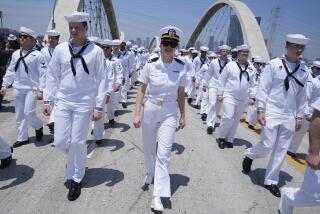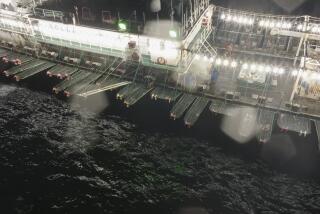Glimpsing the Thrills, Tedium Aboard Navy Ship
- Share via
The sailor sleeps in a room of about 40 men, stacked into the top bunk like a can of soup in a cabinet. But privacy is no problem, he says. There is a curtain, after all.
His rack is right next to the machine room, which hums and seethes, buzzing his bed with tiny, constant tremors. But to 20-year-old Seaman Recruit Dustin Wooldridge, it’s just like “free magic fingers.”
His first trip out he got seasick and had to dash to the head for relief--and endure the ensuing teasing. True, but he hasn’t gotten sick so far on his second voyage.
“There’s a sailor term,” said Wooldridge, a baby-faced sonar technician. “Suck it up.”
And Wooldridge has.
Besides, he couldn’t have had any of this fun back in Tucson, Ariz., where getting seasick was merely a concept.
Wooldridge, admittedly one of the lowest men on the totem pole of the Bunker Hill, is one of nearly 400 Navy men in Ventura County for the weekend as their ship visits Port Hueneme for Seabee Days, with tours of the ship offered between noon and 4 p.m. today and Sunday.
The cruiser is a maze of hallways and rooms, heavy steel doors that close tight to an ankle-knocking seal, and ladders leading up through its labyrinthine levels.
Commissioned in 1986 before the end of the Cold War, the Bunker Hill was built with the fear of a Soviet attack in mind, and expected to knock out an immense threat on the open waters.
Called revolutionary at the time, the ship was the first to feature a vertical launching system, which allows for scores of missiles to launch straight from the deck. One of its major jobs is to detect and track hundreds of potential threats from land, air and sea. So, much of the ship is geared toward watching the world outside: radar, sonar, a nonstop watch of human eyes.
The Bunker Hill was home-ported in Yokosuka, Japan, for the last decade and has spent the last seven months being overhauled in San Diego, catching up with its sister ships that have been closer to home. While in Port Hueneme, the ship will get a checkup.
Some of it looks straight out of the movies: shadowy caverns with blipping sonar screens and a bridge abuzz as the ship fuels off another ship, still clipping along at sea. Other areas are more mundane. There is a barbershop, a tiny store, small dorm-like rooms for the officers and jammed berths for the enlisted men.
It distills 24,000 gallons of water a day, for everything from showers to laundry. It runs on four engines like those of a DC-10 airplane. The ship can easily gulp down 150,000 gallons of fuel, gassing up every three or four days while at sea.
When the ship shifts with the waves, rolling chairs in the rooms squeal across the floor, and the deck rocks like a cradle. At any one point someone on the ship seems to be catching a nap, whether in his rack or tucked into a hidden corner, rocked by the waves and ignoring the sounds of helicopters landing overhead and chains dragging across the deck.
The young sailors seem to constantly be at work--sweeping, mopping, shining, polishing, hauling--or waiting to work. Many are straight out of high school. Most are in their teens or early twenties, and making money for college. Some have families. Some take time to adjust. Some never do.
Seaman Kevin Carver has chafed at taking orders, the low pay and long hours, and some of the tedious work he and his division must do day after day, he said.
“Being in the Navy is for those who need discipline in life,” said Carver, a 22-year-old father who hopes to return to Chicago and work as a cop when he leaves the Navy. “All you learn is how to paint, chip and sand. I stress out because I can’t see my kid, ‘cause I’m on the ship for 12 hours” when in port.
And the tight quarters can get to some.
“I was never claustrophobic,” said Seaman Joshua Corney, 20, of York, Pa. “But in the Gulf, I would have these dreams I was trapped in a box. I’d wake up sweating.”
But the tight quarters also offer wider horizons. The list of countries sailors have visited reaches into the dozens.
Signalman Logan Weaver, a 1987 graduate of Camarillo High School who signed up for the Navy his senior year of high school, has trouble remembering all the ports he has visited in his 12 years of duty.
He has seen a lot more than he could ever see if he had stayed in his hometown of Somis.
“I’ve seen so many different sunsets, with colors you just can’t put words to,” said Weaver, who used flags to communicate with other ships.
“I’ve been sunburned and frost-bitten. I’ve been around the world. I’m proud to be back in my hometown port.”
More to Read
Sign up for The Wild
We’ll help you find the best places to hike, bike and run, as well as the perfect silent spots for meditation and yoga.
You may occasionally receive promotional content from the Los Angeles Times.






